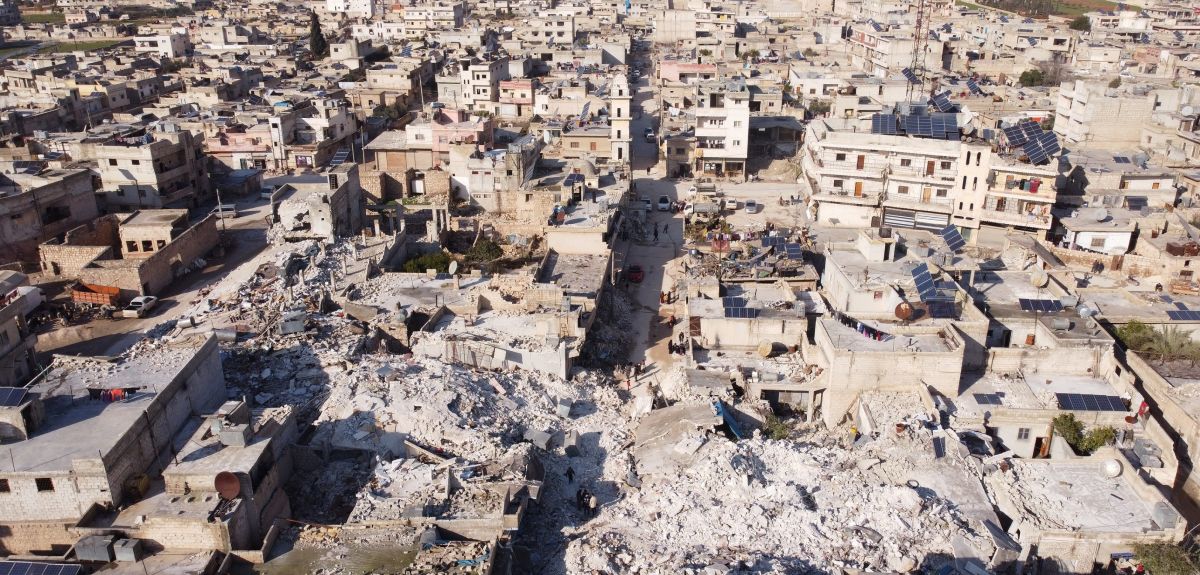
Expert comment: Professor Walker on the Türkiye/Syria earthquake disaster
Professor Richard Walker (Department of Earth Sciences) describes the background to the 6 February 2023 Kahramanmaraş earthquake sequence which has caused widespread destruction both in Türkiye and Syria.

The earthquakes occurred along a major fault line, or more correctly a system of fault lines, called the East Anatolian fault. Past movements on the East Anatolian fault are known from history, including large earthquakes through the last two thousand years. Over millennia the fault movements have left traces through the landscape in the form of displaced rivers, hills, and valleys. We can read these traces to produce fault maps, and through site investigations can determine how often earthquakes occur, and how large they might be. We cannot predict imminent earthquake occurrence, but our knowledge of earthquake hazard distribution can be used as the basis of preparation and mitigation, though the level of preparation varies widely.
Although there are a number of scientific puzzles and details still to unravel, the recent earthquakes should not have come as a complete surprise. Why then did they cause so much destruction and loss of life?
To measure the size of an earthquake we use a type of magnitude called moment-magnitude (Mw), which allows better comparison of earthquakes of different sizes than older types of measurement, such as the Richter scale. Magnitude is logarithmic, with a raise of one unit actually increasing the size of the earthquake, in terms of energy released, by thirty. A magnitude 7 earthquake is approximately 30 times larger than a magnitude 6, and 900 times larger than a magnitude 5. Both the area of fault plane that broke and the average amount of slip on the fault plane scale with increases in magnitude, and as the depth of faulting, in continental regions at least, is usually limited to the upper 15-20 km of the earth, it means that the larger earthquakes typically break longer fault lengths, and involve greater amounts of slip.
The first of the two earthquakes had a magnitude of 7.8. It is now known to have ruptured about 300 km length of the East Anatolian Fault, and with surface slip of over 5 m in places. It was very large, though it is not the only continental earthquake of this size to happen in recent decades. For instance, the 2016 M7.8 Kaikōura, New Zealand Aotearoa, earthquake, and the M7.8 2008 Wenchuan earthquake disaster in China, with almost 70,000 deaths. Though destructive earthquakes have occurred in Türkiye in recent decades, we need to go back to the 1939 Erzincan earthquake (death toll around 33,000) to find an event of equivalent size to that in 2023. Globally, even larger continental earthquakes are known, with events such as the M8.3 Bulnay, Mongolia, earthquake of 1905 and the M8.5 1950 Assam, India, earthquake.
The nature of earthquake disasters, with decades or centuries of calm in any region punctuated by instants of devastation, adds to the difficulty of effecting change, as earthquakes are rarely at the forefront of policy makers’ minds.
The point is that although there are a number of scientific puzzles and details still to unravel, the recent earthquakes should not have come as a complete surprise. Why then did they cause so much destruction and loss of life?
The size of the earthquakes offer only a partial explanation. The first of the two earthquakes ruptured around 300 km length of the fault, meaning that a very large area of land was exposed to strong shaking, and for a long duration as the rupture propagated along the fault. The second earthquake, nine hours after the first, shook and collapsed buildings already weakened by the first as well as widening the region of damage to the northwest. But time and again we see widespread destruction occurring even after relatively modestly-sized events, such as the M6.6 earthquake in Bam, Iran, that killed over 25,000 people out of a population of 80,000.
We must turn to the quality of construction as an important factor, whether from collapse of masonry buildings of traditional construction types, from the effects of war and the displacement of people, from the high-rise buildings erected prior to the modern strict building codes, and from those modern buildings that were built below standard. There were a substantial number of complete building collapses and, given the first earthquake struck at 4.17 AM, when most people were asleep in their beds, the collapses translated into high death tolls.
Earthquake resilience can be achieved, but it requires long-term effort in building understanding of the hazards themselves, of ensuring appropriate building codes are developed and implemented, in raising awareness and preparedness levels within communities, and in empowering those communities to demand resilience.
It is inevitable that this event will not be the last major earthquake disaster we will see in coming years. Many regions of active faulting around the world correlate with regions of high population density, often in nations lacking the resources or political will to build effective mitigation measures. The nature of earthquake disasters, with decades or centuries of calm in any region punctuated by instants of devastation, adds to the difficulty of effecting change, as earthquakes are rarely at the forefront of policy makers’ minds. In the words of earthquake geologist Judith Hubbard ‘People don’t want to listen. They have more urgent problems than something that might not happen for 100 years. Until it happens. How do we make progress?’ There is no easy solution.
As we continue to rapidly build and enlarge urban centres across the continents, we are ever increasing the exposure and vulnerability of those populations. Earthquake resilience can be achieved, but it requires long-term effort in building understanding of the hazards themselves, of ensuring appropriate building codes are developed and implemented, in raising awareness and preparedness levels within communities, and in empowering those communities to demand resilience.
Over the coming weeks and months the death toll will continue to rise, but the news will fade from our screens. Memories will fade also, in the minds of the public and of the policy makers, until the next disaster occurs. Let us hope that the memories, and the will of policy makers at national and international level, do not fade too quickly this time to enact change.
[postscript: The relief efforts do not stop when the newspaper reports end, and there is continued need for aid for those who survived, in both countries affected. Please continue to donate to these important efforts].
 New analysis of archaeological data reveals how agricultural practices and governance have shaped wealth inequality over the last 10,000 years
New analysis of archaeological data reveals how agricultural practices and governance have shaped wealth inequality over the last 10,000 years
 Cambridge victorious in Women's and Men's Boat Races 2025
Cambridge victorious in Women's and Men's Boat Races 2025
 Expert Comment: Ethical and legal challenges of uterus transplants in Mexico
Expert Comment: Ethical and legal challenges of uterus transplants in Mexico